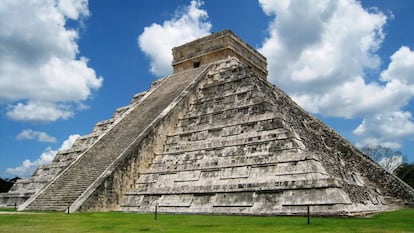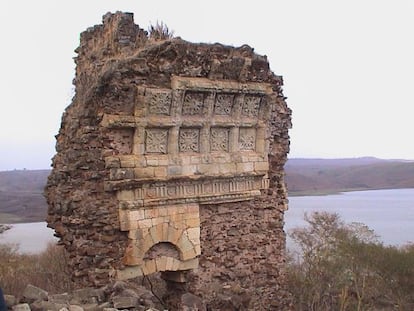Found: Mystery pyramid hidden within iconic Mayan temple
Discovery could shed light on little-understood early period of Maya culture on Yucatán Peninsula


Researchers from the National Autonomous University of Mexico (UNAM) have found a third pyramid nestling within the famous 30-meter-high Temple of Kukulkan at the country’s vast Mayan archeological site known as Chichén Itzá.
Investigators discovered a second pyramid measuring 20 meters in height back in the 1930s but the surprise discovery of an even smaller and older structure within one of the world’s best-known monuments means the history of worship at the Kukulkan pyramid – usually referred to as El Castillo – goes back further than previously thought.
“It’s like Russian dolls; inside one we found another,” said project coordinator René Chávez of the new pyramid.
The Kukulkan pyramid is built on a sacred sinkhole where human sacrifies were carried out
The smallest structure is 10 meters in height and dates back to between 550 and 800AD, or before Mayan culture was influenced by other populations from central Mexico. It was a period of great turmoil on the Yucatán Peninsula according to experts.
The discovery could help shed light on the evolution of what is one of the largest ceremonial centers in the Americas. “We don’t know much about this period but if we can keep investigating, we will learn more about the settlement,” said archeologist Denisse Lorenia Argote.
The structure, discovered using non-invasive electrical tomography, contains a three-meter-high shrine as well as staircases, walls and columns. There is also a hollow area, which may be a collapsed roof.
The rise of Mayan culture has left a rich architectonic legacy, with large temples aligned to astronomical events and dedicated to agricultural and sacred purposes. Chichén Itzá is part of this tradition which saw larger structures built over smaller existing ones.
In the case of the Kukulkan pyramid, the larger – and newer pyramid – possibly dates from the 11th or 12th century, which is what visitors can see today.
Named El Castillo by Spanish conquistadors, the Kukulkan pyramid has four enormous staircases and as many stairs as days of the year. Its interior contains chambers for human sacrifice. But what makes the monument unique relates to sunlight. During the equinoxes, three hours before sunset, the play of sunlight and shadows on the temple resembles the descent of the feathered serpent, or Kukulcán, the god which comes from the west.
It’s like Russian dolls; inside one pyramid we found another Archeologist René Chávez
An icon of Mayan civilization, the Kukulcán pyramid, like the rest of Chichén Itzá, was abandoned centuries before the arrival of the Spanish. Although the reasons for this are hotly disputed, it has traditionally been asserted that internal struggles at the end of the 12th century led to the site being laid to waste.
The new discovery of another pyramid within El Castillo is not the only surprise thrown up at the site in recent years. Two years ago, the geophysics institute at UNAM established that the monument is built on a natural sinkhole some 25 meters in diameter.
These sinkholes, formed when limestone rock collapses to expose groundwater, were sacred in Mayan culture, functioning as pilgrimage sites and as the location for human sacrifices.
English version by George Mills.
Tu suscripción se está usando en otro dispositivo
¿Quieres añadir otro usuario a tu suscripción?
Si continúas leyendo en este dispositivo, no se podrá leer en el otro.
FlechaTu suscripción se está usando en otro dispositivo y solo puedes acceder a EL PAÍS desde un dispositivo a la vez.
Si quieres compartir tu cuenta, cambia tu suscripción a la modalidad Premium, así podrás añadir otro usuario. Cada uno accederá con su propia cuenta de email, lo que os permitirá personalizar vuestra experiencia en EL PAÍS.
¿Tienes una suscripción de empresa? Accede aquí para contratar más cuentas.
En el caso de no saber quién está usando tu cuenta, te recomendamos cambiar tu contraseña aquí.
Si decides continuar compartiendo tu cuenta, este mensaje se mostrará en tu dispositivo y en el de la otra persona que está usando tu cuenta de forma indefinida, afectando a tu experiencia de lectura. Puedes consultar aquí los términos y condiciones de la suscripción digital.
More information
Últimas noticias
Pinochet’s victims grapple with José Antonio Kast’s rise in Chile
Reinhard Genzel, Nobel laureate in physics: ‘One-minute videos will never give you the truth’
How Japan is trying to avert ‘digital defeat’
The complicated life of Francesca Albanese: A rising figure in Italy but barred from every bank by Trump’s sanctions
Most viewed
- Pablo Escobar’s hippos: A serious environmental problem, 40 years on
- Why we lost the habit of sleeping in two segments and how that changed our sense of time
- Charles Dubouloz, mountaineering star, retires at 36 with a farewell tour inspired by Walter Bonatti
- Trump’s obsession with putting his name on everything is unprecedented in the United States
- The Florida Keys tourist paradise is besieged by immigration agents: ‘We’ve never seen anything like this’










































